Nokta Anfibio – our review of the new metal detector and feedback on its performance! (tips and finds+)
Recently, at the last global digging rally Detectival 2018 in the UK, the Turkish manufacturer of metal detectors Nokta/Makro announced a merger of brands. Now there won’t be a separate Nokta or a separate Macro – there will be Nokta-Macro. Everything is very simple! And the first product of the joint brand is a new product for 2018 – a series of metal detectors Nokta-Macro Anfibio Multi, Nokta-Macro Anfibio 14 and Nokta-Macro Anfibio 19.

As is clear from the names, the differences in the series are only in the search frequency(s). The series is designed to completely replace the old line of Nokta Fors metal detectors: Nokta Fors Core, Nokta Fors Gold, Nokta Fors Relic.
Three new Anfibio models
Содержание статьи:
As I wrote above, the three new models of the Anfibio series differ only in search frequencies:

Nokta Anfibio Multi:
Metal detector with three search frequencies 5/14/20 kHz, a universal device for treasure hunting, beach searching, coin digging and antiques. The number of search programs is the same with the Anfibio 14 model. Let me remind you that in the “Multi” version all frequencies work only one by one, that is, this is not a multi-frequency device like Minelab, where all frequencies work simultaneously! The version will cost more than all the others in the series.
Nokta Anfibio 14:
Single-frequency version with an average frequency of 14 kHz for all search tasks. Perhaps the best option from the entire line, it should cost less. The frequency of 14 kHz is excellent for all types of search, it is not for nothing that almost more than 50% of VLF metal detectors in the world operate at a frequency of 14 kHz +/- or have this frequency available for search.
Nokta Anfibio 19:
The gold-mining version of the Anfibio series metal detector operates at a frequency of 19 kHz. Let me remind you that this frequency is best suited for beach searches, for finishing off the “fat” spots of the cop for the presence of small coins and jewelry. There are fewer search programs, a slightly modified menu.
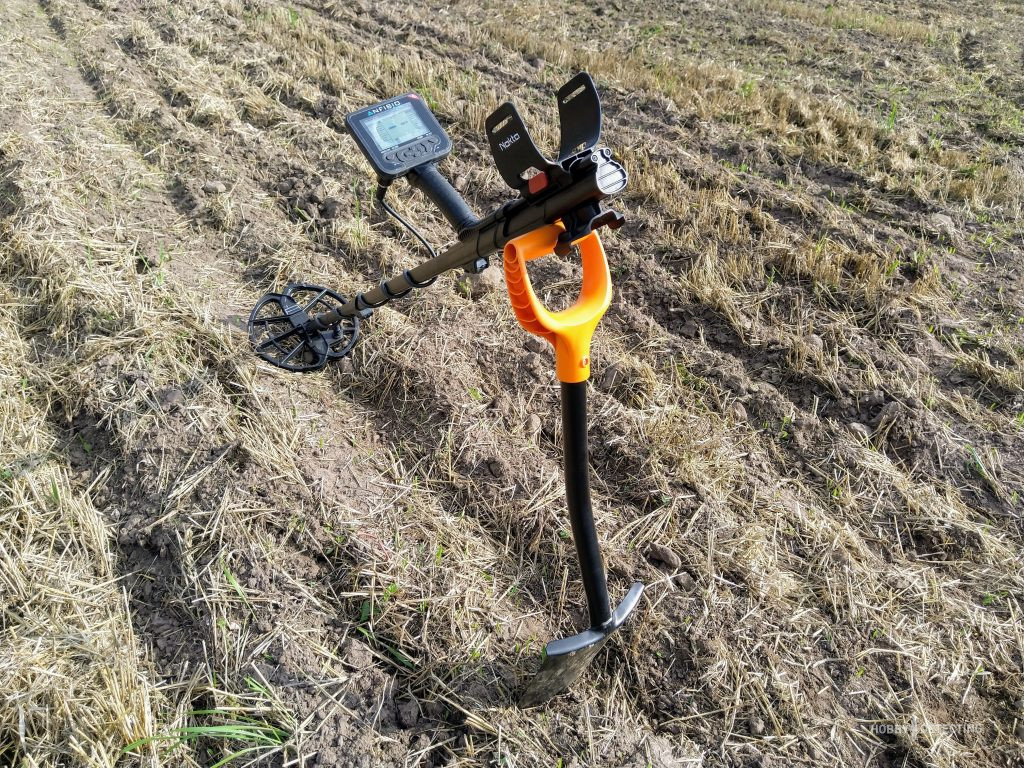
Design of the Nokta Anfibio Multi metal detector
Our team was chosen to test the prototype (pre-release test) to check the functionality and performance of the metal detector, and therefore it passed all the necessary tests and comparisons with other top metal detectors currently present on the metal detector market in the world. We will talk about this below, but for now about the design features of this model.

Nokta Anfibio received all the best developments that were used in previous models of metal detectors – Nokta Impact and Macro Cruiser. An improved rod with excellent weight balancing of the metal detector was used from Nokta Impact, and a metal detector control panel, power solutions (built-in battery) and a metal detector circuitry were used from Makro Cruiser. Let me remind you that the coils for the Nokta Anfibio and Makro Cruiser series are interchangeable!
The metal detector has received a new lightweight rod with the ability to quickly change position; just press the big red button once and the armrest can be very easily moved on the rod. An interesting and original solution that I have never seen anywhere else! Very similar to the CTX3030, but there is a regulator in the floor of the armrest.
Just like in the Makro Cruiser, under the armrest there is a mount for an additional battery compartment, which can be connected while searching and charged the device on the go. A good solution if you are away digging for several days and you don’t have electricity – only batteries can save you!
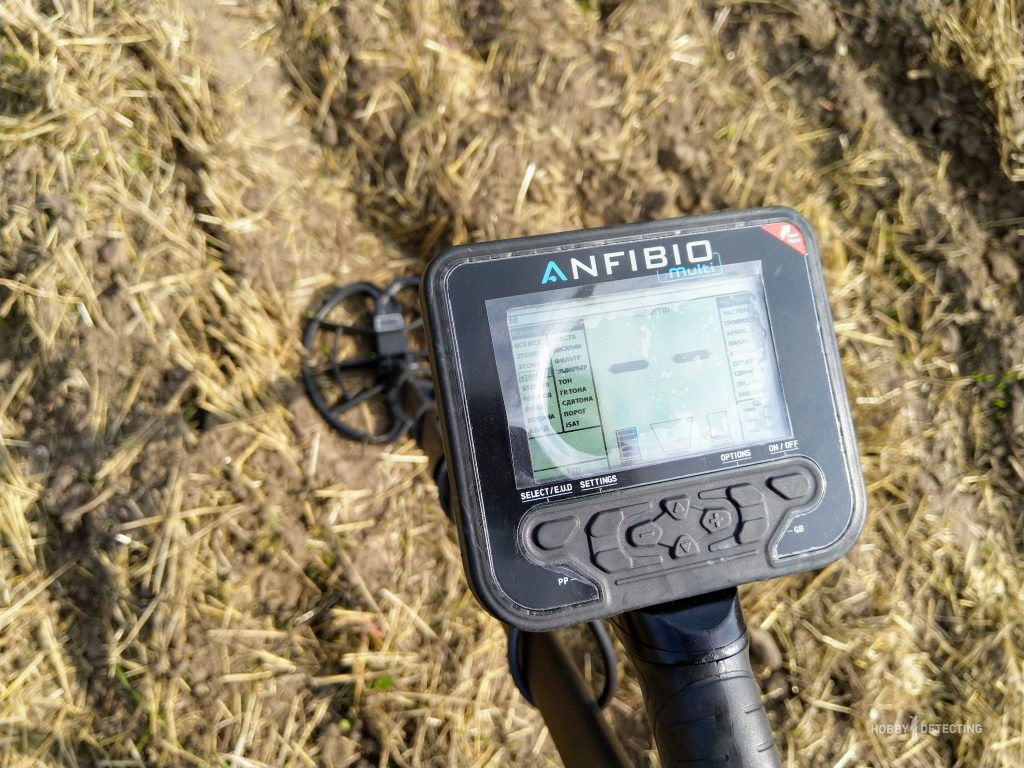
Also, along with the new metal detector, a completely new coil was presented – a round 11″ DD! And it really added a couple of centimeters of depth compared to the standard coil for the Macro Cruiser 11″ ellipse.
The rod is assembled very quickly and easily, the latches are very similar to those in the Impact, they are comfortable and hold the rod firmly, no play has been noticed so far.
The wire for the coil does not pass inside the rod, as was the case with the Nokta Impact metal detector, but wraps around it, which is true, because the coil can also be used from the Macro Cruiser, which means the length of the wire should be the same.

The metal detector also received a new and comfortable handle. The height of the handle is pretty standard, the only thing I didn’t like a little was the small buttons on the front panel of the device – they can be a little difficult to reach, especially for people with small hands and short fingers. I almost never had such problems, with a few exceptions.
The instrument panel is completely identical to the Macro Cruiser, the only change is that backlighting for the buttons has been added so that you can see the buttons even in twilight or darkness. The finds scale is 0-99 (VDI), where the ferrous metals scale goes up to 0-15.
Let me remind you once again that Nokta Anfibio has stepped far forward in terms of weight and overall ergonomics of the metal detector. The lighter the device, the better balanced it is, and it fits well in the hand, the longer you can dig and the more finds you can recover! This is without a doubt.
Let’s not forget about one of the main advantages of these metal detectors – they can be submerged under water to a depth of 5 meters.
Search modes of the Nokta-Makro Anfibio Multi metal detector
In terms of modes, everything is simple here, in the Multi version there are 9 search modes, let's go through each of them:
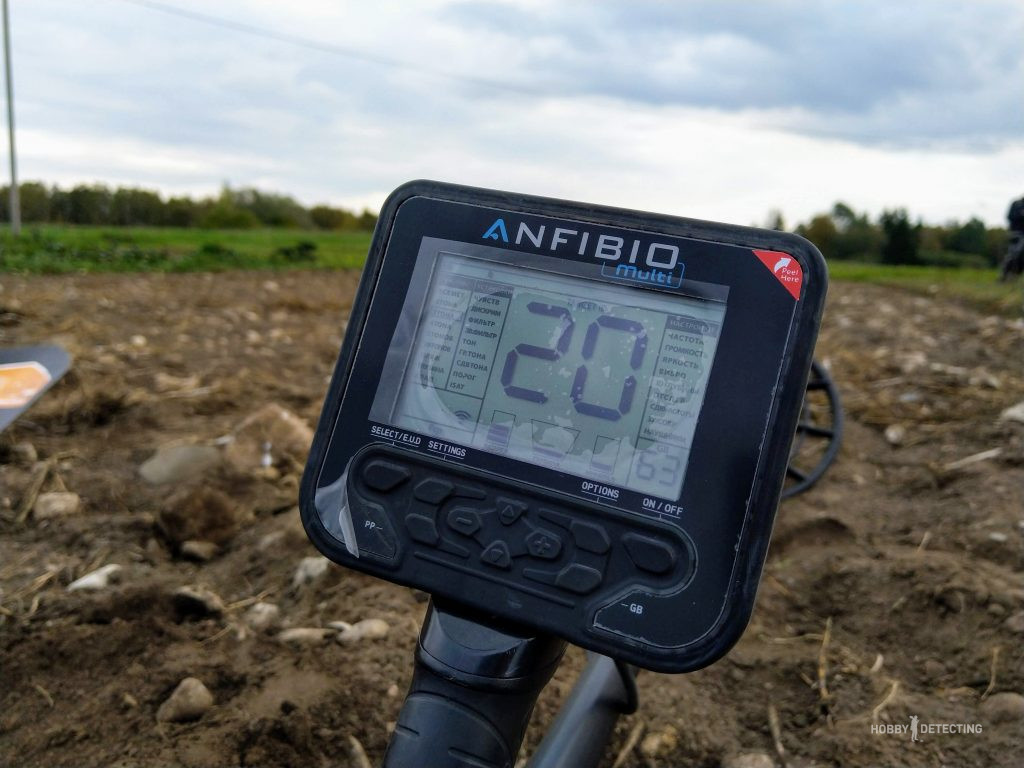
All metals
Standard mode for searching all metals. There is no discrimination, the voice acting is monotone. In this mode, the device reacts actively to hot stones and, in general, is more sensitive to all metal objects in the ground. I recommend this mode for clean places where everything needs to be dug. Suitable for searching in the forest, as well as for finishing off already dug spots.
2 Tones
Two-tone voice mode. The threshold for changing the tone can be changed, for example, moving it from 15 (standard) to 20. A fairly deep mode, as usual in all Nokta-Macro metal detectors, is suitable for regular search and exploration of new places.
3 Tones
I noticed that there is no difference in 3 tone mode between Noct Anfibio and Macro Cruiser. 3 tones work very quickly at sensitivity up to 90 (89 inclusive), and after 90 the device already has a different recovery speed, so if you are working in a garbage dump, then in 3-tone mode set the sensitivity to 89, and if you are digging in a regular field, then above 90 .
4 Tones
Like the Makro Cruiser metal detector, this mode is very sensitive and quite noisy, so you need to use it wisely. As it seemed to me from my tests and search experience, this mode has become even more sensitive and noisier, sometimes I set the sensitivity to the level of 84-87, but in some places it reached 95. I recommend it for general search too, for most search tasks this mode is suitable Great!
5 Tones
Five-tone voice mode. Not too deep, but very stable and not noisy. I used it when searching in a field with stubble, for example, when false signals appeared when touching grass and plants.
99 Tones
Polyphony mode. It must be used wisely, of course, I don’t really like polyphony and have used it little, but with it it may be easier to determine the type of metal, even if it gives a high VDI, but from the sound it is clear that we are dealing with foil, cork or deep rusty iron.
Beach
Very quiet mode with a preset high discrimination level for beach searching. Objectively, I’ll say that it’s also great for digging in wet fields, where other modes become too noisy. The mode is perfect for the beach, which is why it has such a name.
Depth
Mode with a low level of recovery and maximum depth. I almost never use it for searching, but you can test it in your own conditions. In this case, you need to walk slowly and make slow movements with the coil, then you will achieve maximum performance.
Treasure
In my case, when testing the prototype, it was a static mode that responded to large metal objects in the ground. In general, this mode is perfect for wartime digging, because if you raise the coil a little higher above the ground, you can weed out all sorts of small things on the surface and dig only larger objects. I recommend using it at 5 kHz.
There are no changes to the other settings with the Macro Cruiser – the device allows you to change the tonality, shift the tone threshold and make the necessary settings for ground balance, threshold tone, shift the frequency, etc. Everything you need to search is in the settings.
Cop's experience with the Nokta Anfibio Multi metal detector
The most interesting chapter of this review, I think. 🙂

During the entire test period, the device was subjected to all tests – digging on the beach, plowing, field, garden. Survived being submerged in water, digging in heavy rain. It also survived a major competition at our test site with buried targets, where it was tested in comparison with the main top metal detectors for 2018.
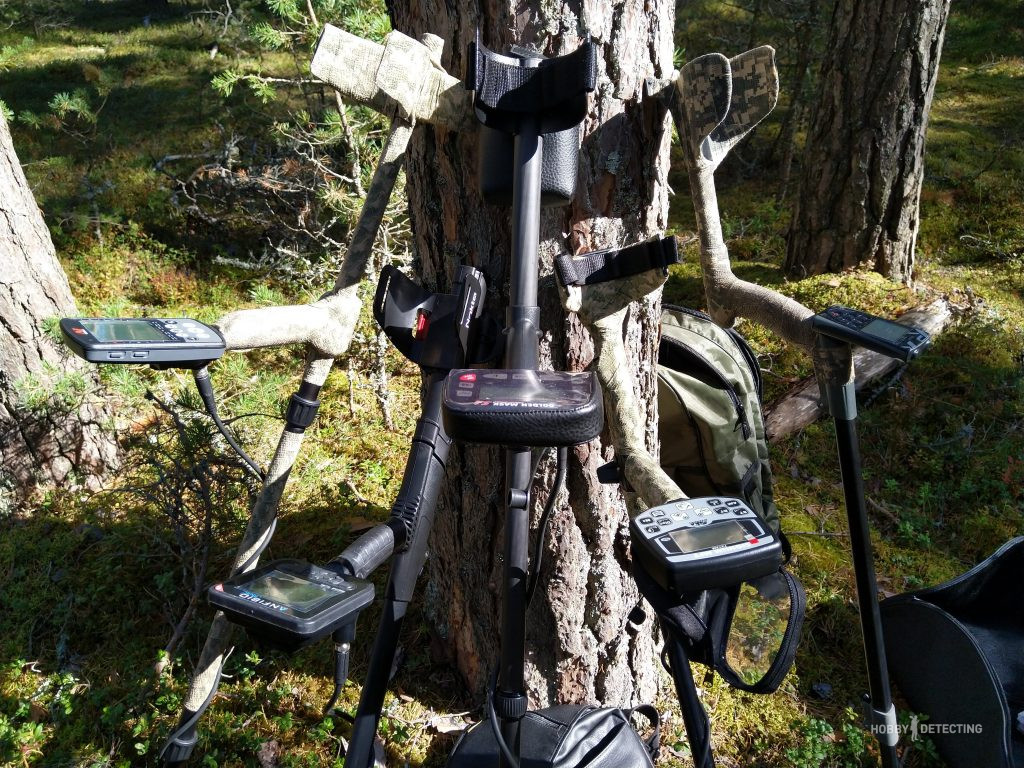
In the vast majority of searches, I used the 4-tone program, sometimes switching to 3-tone or beach mode. The device quite clearly indicates useful finds and coins; in almost all cases, I was not mistaken when digging a find out of the ground.

For example, on a place I had broken, I picked up such a pendant made from a silver coin from 1671, during the reign of King Charles XI of Sweden, a coin worth 1 mark.
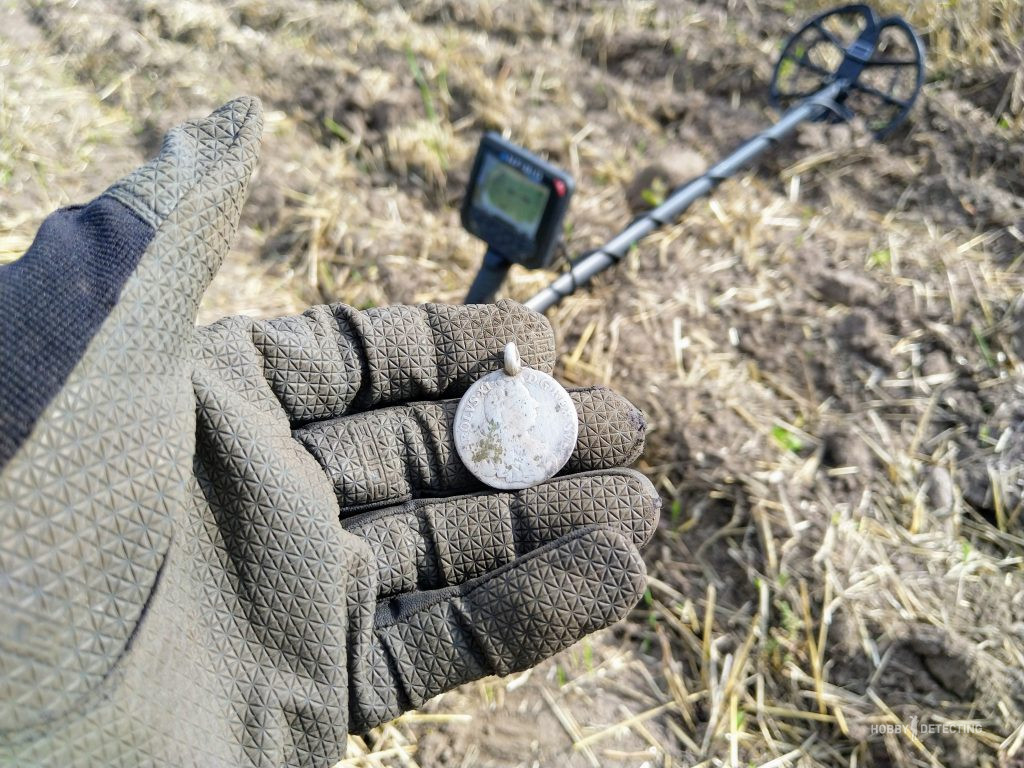
I have walked through that place more than once, as well as several other groups of treasure hunters over the past five years. They walked there with me, but as they say, what you are supposed to find will be found by you, and not by anyone else. 😉 So don’t believe in knocked out places.
Of course, in some places the device can be quite noisy, especially when it comes to searching in 4-tone mode and over stubble or an overgrown/freshly mown field. When you hit the plants, interference and false signals appear, but in this case you need to switch to quieter and less deep modes, and then return to the same field when it is completely free of everything, representing a normal plowing.

Of course, in some places there was interference from the power line, but it was easily tuned out when the frequency shifted, so don’t forget about this function when setting up your device – you should always choose the quietest operating mode.
When tested and compared with other devices, the deepest mode turned out to be the following: sensitivity at 93, correct ground balance, 4-tone program, frequency 14 kHz. With these basic settings, the metal detector saw all the targets in our testing area with coins buried at different depths.

Basically, I dug for 4-6 hours each time and, to be honest, my hand didn’t get too tired, thanks to the good balance and light weight of the metal detector. You can dig for a long time, the built-in battery holds a charge well, and in 6 hours of digging I didn’t lose it; moreover, only one point in the charge dropped.
The round coil is much more interesting than the earlier ellipse and the depth has also increased, which is good news. Coins, even small ones, rose from good depths in the knocked-out fields; sometimes it was necessary to dig a hole deeper than usual, removing not yet an additional half bayonet of soil in depth.

Some small items were found after the comrades had passed and in their tracks. I don’t know whether it was luck, inexperience, or the work of the metal detector, but following the trail of the comrades, two coins were picked up for exactly one kopeck!

Nokta-Macro Anfibio works with wireless headphones that fit both Impact and Macro Cruiser. Such an interesting interchangeability, so as not to reinvent the wheel. Coping is even more productive with headphones on, so I definitely recommend using them!  As you can see in the photo, our soil is very rocky, and this makes searching difficult, because stones at depth can maximize good targets. There is no way to fight this, so after every plowing we come across some great finds in our fields! Anfibio, like the Cruiser, has an EUD mode, so when digging in rocky fields, it is better to turn on this mode; it allows you to better recognize objects under difficult soil or stones. Partly, this was the little secret that Anfibio, at the extreme exit, picked up more coins than the rest of the devices that the comrades had.
As you can see in the photo, our soil is very rocky, and this makes searching difficult, because stones at depth can maximize good targets. There is no way to fight this, so after every plowing we come across some great finds in our fields! Anfibio, like the Cruiser, has an EUD mode, so when digging in rocky fields, it is better to turn on this mode; it allows you to better recognize objects under difficult soil or stones. Partly, this was the little secret that Anfibio, at the extreme exit, picked up more coins than the rest of the devices that the comrades had.

It's always nice to bring up finds when everyone else is almost empty, isn't it?
Summary of the metal detector
It seems that the manufacturer Nokta-Macro has completely completed its line of professional metal detectors with the release of the Anfibio series. It will be interesting to see when the manufacturer releases an entry-level metal detector and a multi-frequency professional model; they promise that this will be next year (2019).
According to Anfibio, we can say the following – the device is worthwhile, it detects finds and no problems were noticed with it. Ideal as a universal metal detector for most types of search.

Light weight, good balance of the rod, built-in battery, sufficient depth – the Nokta-Makro Anfibio metal detector has all this. I consider the Anfibio 14 model to be optimal if you are just digging for coins and antiquities, but if you are looking for more on the beach, then the Anfibio 19 model is more suitable for you, and if you are a digger in all directions, then the best choice here is the Anfibio Multi model, which has 3 frequencies (5/14/20 kHz).
All devices come complete with wireless headphones and this is quite a significant cost savings if you look at the price of wireless headphones for other metal detectors.
Do you have Anfibio? If yes, then share your impressions, leave your feedback in the comments, it will be very useful for our comrades!
No fluff on the cops!
